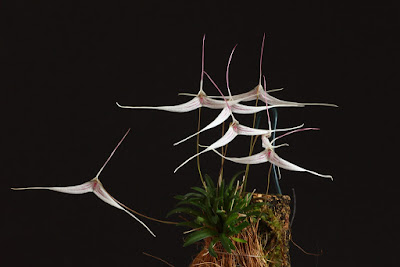Trisetella hoeijeri is native to Ecuador. In particular it is located in the province of Morona-Santiago, where it grows as an epiphyte in the humid and fresh mountain forests at an altitude of 1800 meters...
Trisetella hoeijeri also called as Hoeijer's Trisetella, is a species of the genus Trisetella. This species was described by Luer & Hirtz in 1986.
IDENTIFY TRISETELLA HOEIJERI
Trisetella hoeijeri is native to Ecuador. In particular it is located in the province of Morona-Santiago, where it grows as an epiphyte in the humid and fresh mountain forests at an altitude of 1800 meters.
It is a mini-miniature sized, densly caespitose, epiphytic, cool growing species with erect ramicauls that are enveloped basally by 2 to 3 loose, ribbed, tubular sheaths and up to 3 cm long leaves.
Hoeijer's Trisetella blooms on an erect, 3.75 cm long, very slender, smooth, congested raceme arising from low on the ramicaul that has a succession of solitary flowers held well above the leaves and occuring at any time of the year. The flowers are 3.5 cm in diameter.
TRISETELLA HOEIJERI CARE AND CULTURE
Cultural information should only be used as a guide, and should be to be adapted to suit you. Your physical location; where you grow your plants, how much time you have to devote to their care, and many other factors, will need to be taken into account. Only then can you decide on the cultural methods that best suit you and your plants.
Light:
Trisetella hoeijeri needs a light level of 18000-24000 lux. The direct rays of the sun must be shielded. The ideal photoperiod is 12-13 hours.
Temperature:
It is an intermediate-cold thermal requirements species. Recommended daytime temperatures are 20-22 ° C, while nighttime temperatures should be 11-13 ° C.
Humidity:
If Hoeijer's Trisetella is cultivated in pots, it also adapts to 65-70%. If instead it is placed on a raft, it needs 80-85%.
Substrate, growing media and repotting:
Trisetella hoeijeri can grow it both in pot (as a substrate we use sphagnum together with perlite in the proportion 1: 1), or on a raft. This species needs to have its roots immersed in the moss, so it is very suitable to cover the raft with live musk. Otherwise you put the coarse fiber sphagnum both under and over the roots.
Watering:
It is water abundantly and regularly throughout the year. The substrate should never become completely dry, because this would lead to very fast decay of the plant. The best practice is to keep the substrate always uniformly moist.
Fertilizer:
This orchid is fertilized every three waterings (but no more often than once every 10 days) with 1/4 of the dose reported on the bottle of a special liquid fertilizer for orchids. Before fertilizing the plant it is necessary to water it, to avoid the harmful contact of the fertilizer with the dry roots.
Rest period:
Trisetella hoeijeri does not need a rest period. Such conditions should maintain throughout the year. They can bloom in any season, but it is very important to keep the right temperatures.















COMMENTS